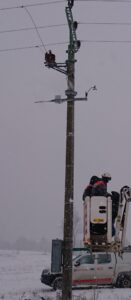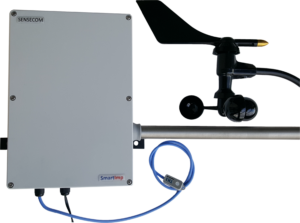Remote monitoring of frost intensity
Remote monitoring with SENSECOM-KL2 series
At times of higher risk of icing, work crews were dispatched to problem areas to survey conditions. In the event of heavy frost, the crew was able to either frost heaving lines on the spot or induce a high frequency signal into the lines with special equipment or load the lines with a higher current. The goal was to heat the lines so that the frost would at least partially melt.
The deployment of relatively inexpensive ice-measuring sensors capable of sending data to the SENSECOM-KL series wide area network has enabled monitoring of ice intensity, especially in icy areas. The devices are also equipped with basic meteorological sensors such as temperature, humidity, or wind direction and intensity. The conditions that lead to an increase or decrease in frost can thus also be monitored and its development can be dynamically predicted. The devices run on battery power for a long time (several years) and are thus maintenance-free. The dispatching of the high voltage distribution network can dispatch a crew to a specific location where there is a risk of line breakage or damage, thus ensuring timely implementation of measures to reduce icing on the lines.
The deployment of SENSECOM-KL2 units in frost zones made it possible to easily monitor the size of the frost, save costs on trips and avoid costly repairs of damaged lines. This allows the emergency crews to concentrate more on dealing with accidents that cannot be predicted.
SENSECO-KL series devices are also installed elsewhere where information on frost size is crucial, such as telecommunication towers, high-rise buildings and partly transport. This ice size sensor does not help to identify the formation of ice (other types of sensors are used for this), but it can signal the dynamics of changes, i.e. the increase or decrease of the already formed ice and the meteorological conditions for its formation.
Frost intensity remote monitoring including basic meteo


